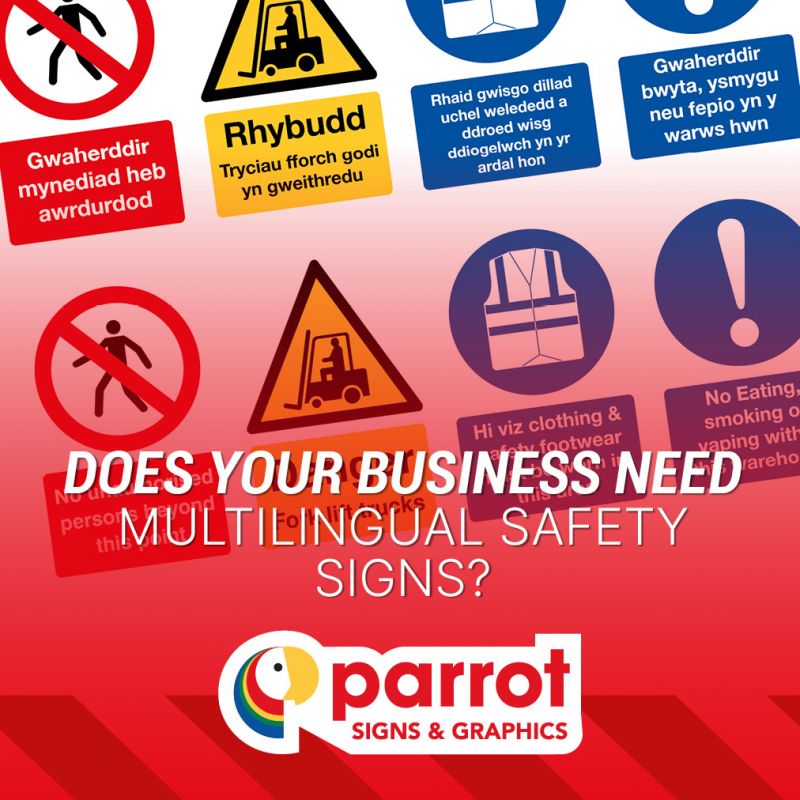Does Your Business Need Multilingual Safety Signs
Mon 15th September 2025In today’s increasingly diverse workplaces, safety signage that speaks only English may no longer be enough. With over 4.1 million UK residents proficient in English but not using it as their main language, business owners should consider whether their signage truly serves the people it’s meant to protect.
Does your business have employees or visitors who have English as a second language?
According to the 2021 Census, the most common non-English languages spoken by working-age adults in England and Wales include Polish (611,845 speakers), Romanian (471,954), Panjabi (290,745), and Urdu (270,000). These figures reflect not only the linguistic diversity of the UK but also the reality that many workplaces, especially in sectors like manufacturing, logistics, construction, and agriculture, employ individuals whose first language is not English.
There are variations in languages spoken between cities and regions of the UK. For example the cities of Luton, Leicester and Birmingham have higher proportions of people who have English as a second language but also have differences in which foreign languages are the most common. In addition, there are laws which govern communications, including safety signs, in devolved regions of the UK.
Wales: Welsh First, by Law
In Wales, bilingual signage isn’t just good practice, it’s a legal requirement. Since 2016, all new public signs must display Welsh first, followed by English. This applies to both internal and external signage, including temporary signs. Businesses operating in Wales must ensure that Welsh text is accurate, visible, and given equal prominence. As the Welsh Government puts it: "Ble mae’r Gymraeg?"—Where’s the Welsh?—is more than a slogan; it’s a standard.
Scotland: Gaelic and Scots Considerations
While not legally mandated for all businesses, Scotland’s commitment to linguistic inclusion is growing. Scottish Gaelic is spoken by over 135,000 people, and Scots by more than 1.5 million. Public bodies are encouraged to include Gaelic in signage where appropriate, particularly in the Highlands and Islands. For businesses serving local communities or tourists, incorporating Gaelic phrases like “Fàilte” (Welcome) can foster goodwill and cultural respect.
Northern Ireland: Irish and Ulster Scots Recognition
The Sign Language Bill introduced in 2025 also recognises Irish Sign Language and British Sign Language, but when it comes to spoken languages, Irish and Ulster Scots are increasingly visible in public signage. While not yet mandatory for private businesses, the inclusion of Irish, spoken by around 124,000 people, is supported in areas with strong cultural ties. Phrases like “Slán sábháilte” (Stay safe) can add a meaningful local touch.
Why It Matters
Multilingual signage isn’t just about compliance; it’s about safety, clarity, and inclusion. A sign that says “Danger: High Voltage” may be ignored or misunderstood by someone who doesn’t read English fluently. Translating key safety messages into the languages spoken by your workforce or customer base can reduce accidents, improve communication, and demonstrate cultural awareness.
Standardised safety symbols are a universal language that transcends words. Whether it's the ISO 7010 'no smoking' symbol, a high-voltage warning symbol, or an Eye Protection Must Be Worn Sign with an image of someone wearing eye protection, these visuals offer immediate recognition across cultural and linguistic boundaries. When combined with multilingual text, they reinforce key messages and reduce reliance on written language alone. Businesses should ensure symbols are consistent, unambiguous, and positioned prominently to support clarity and compliance.
Getting Started
If you’ve got a diverse workforce or customer base and you feel that signs in English alone are not having the right impact in your workplace, then look into creating multilingual signage. Start by auditing your workforce demographics and identify the most commonly spoken languages. Engage your employees in helping to create better signs that will improve safety for themselves and your visitors.
Safety signage should speak the language of safety, whatever that language may be.
